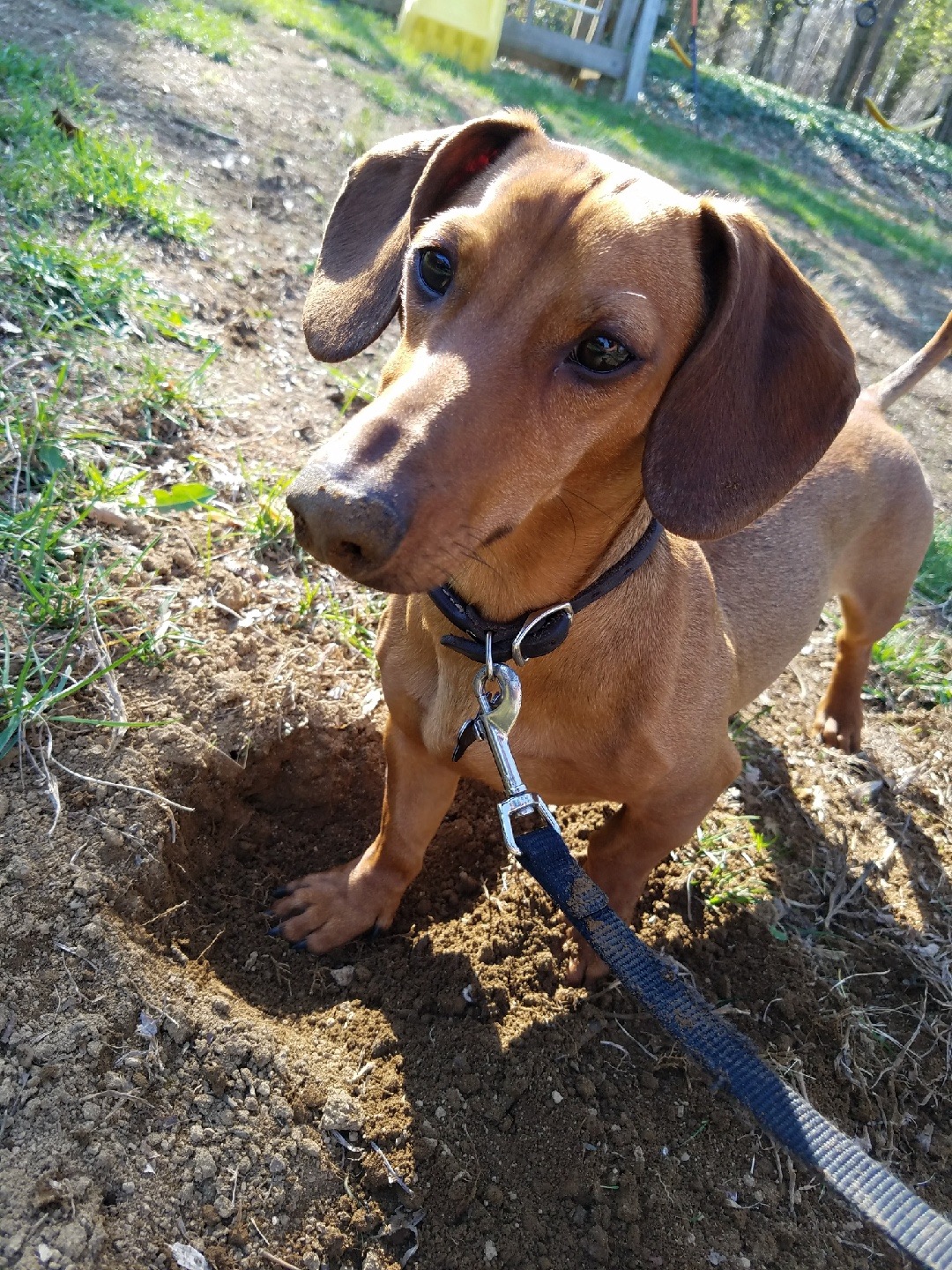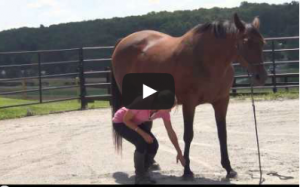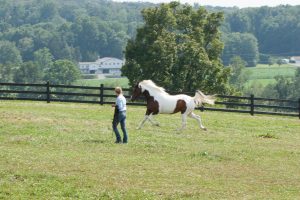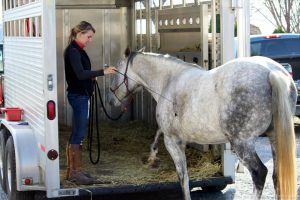
Most of us equestrians find that our love of animals extends beyond horses, many of the riders I know also have dogs and would love to be able to safely bring their dog to the barn.
Horses and dogs can seem natural companions, but both pose a danger to the other – especially when scared or nervous.
The good news is that many dogs can be taught to feel comfortable around horses. It’s vital to be proactive about your pet’s safety though. Here are six tips for keeping a dog safe around horses, written by Richard Cross, editor of The Dog Clinic.
Before we get to the tips, always be over-cautious with dogs around horses. Never let a dog loose in paddocks or riding arenas, as even an accidental kick can cause serious injury or death. I also recommend hiring a trainer to help with socialization, introductions and obedience.
1. Understand Your Dog’s Ancestry

It might not seem like a chihuahua has much in common with a wolf, but domestic dogs still share traits with their wild ancestor. The instincts to chase and hunt, for example, are strong in many breeds.
A dog is unlikely to see a horse as actual prey – it’s more likely to be scared of its size and strange body language. But the instinct to chase can override fear, which is why a nervous dog might sprint after a horse that starts to run. Younger dogs might also want to play, but the lack of a common body language means the horse won’t understand.
Similarly, horses have an instinctive fear of wolves – and their best defence is to bolt. If the dog gets too close, a horse may also kick. This can cause severe damage – not to mention putting a rider in danger.
While we want our animals to get along, it’s clear that neither the horse or dog are “misbehaving.” They are both acting according to their natural instincts. If you want your dog to be safe around horses, it’s your responsibility to teach him.
2. Socialising Your Dog With Horses is Essential
It’s vital for your dog to feel comfortable around horses – and vice versa. This is called socialisation, and should happen before you properly introduce your two animals.
Socialization is most effective for puppies. This is why trainers recommend exposing a dog to as many situations as possible during the formative early weeks. You canstill teach an adult dog to feel comfortable around horses though – it just might take a bit longer.
The best way to socialise a dog with horses is to create positive associations. You always want to stay below your pet’s fear threshold, and gradually increase the intensity at a pace he feels comfortable with.
- Start by taking your dog to place he can see a horse in the distance. There should be a fence so the horse can’t come over to investigate, and always keep your dog on a leash.
- Don’t make a fuss about the horse, but wait for your dog to see it naturally. When he does, treat him and play a game with a toy. Repeat this whenever he looks up at the horse.
- Come back to the same spot several days in a row to practice.
- Once the dog is comfortable with a horse at your current distance, move a bit closer and repeat the same process. If your dog shows signs of anxiety or stress, you’ve pushed him too far, and should move a bit further away.
- Gradually decrease the distance until your dog is happy to be near a horse.
The goal is to create positive feelings withoutcausing stress. When your dog can be near a horse without reacting, you’re ready to make the introduction.
This is also a good time to mention that some dogs may never be comfortable around horses. If your dog reacts aggressively or is just highly energetic, you may want to consider whether it’s fair on both the horse and dog to force them together.

On a related note, always keep your dog on a leash around horses during this phase. You might think your pet has perfect recall, but the chasing instinct can kick in if he sees a horse running.
3. Know Canine Body Language Cues
I mentioned in the previous section that you should stay below your dog’s fear threshold. To do this, it’s important to recognise body language that indicates fear or defensiveness.
The most obvious indicators are flattened ears, cowering and tucking the tail between the legs. Barking and growling are also clear signals that the dog isn’t happy.
There are more subtle signs to watch for though. Lip licking, panting, dilated pupils, yawning, looking away from the horse and pacing can all indicate a dog isn’t happy with the situation.
If you notice these signals, stay calm and create some more distance between your dog and the horse.
4. Introduce Your Horse and Dog (Gradually)
The key to a successful introduction is to take it slowly. You can’t force a dog and horse to relax around each other, so the process should be gradual.
Start by giving your dog time to sniff the barn without the horse being present. Walk him around on a leash, so he can get used to the new smells and sounds. You might even want to provide your horse’s saddle blanket to sniff.
You can then put your horse in a paddock, but make sure he’s not tethered so he can move away. Approach with your dog on a leash, giving praise and treats and watching for signs of stress or anxiety. If your dog barks, growls or just looks scared, back off to a point where he feels calm.
Over time, you’ll be able to move closer to the horse before your dog shows signs of anxiety. This can take weeks, but it’s important not to rush the process. Once your dog is happy with the horse in the paddock environment, you can practice in other situations, including the barn or on a trail.
5. Stay Safe When Out Riding
Before you can even consider riding with a dog, he needs to respond to obedience commands in all situations. If another dog, rider, cyclist or hiker comes around the corner, you need to knowyour dog will listen to what you say.
Crucially, he needs to respond to sit, stay, leave and down at a distance, so you can put him in a waiting position without needing to dismount. Many people are surprised their dog can’t do this, as dogs usually run to their owner before responding.
Once your dog knows all the basic commands, and responds to them even with distractions, start practicing with your horse nearby. It’s often useful to get a friend to ride your horse while you train your dog.
You also need to teach your pet to walk at a safe distance from the horse, but without moving too far ahead or behind. Some dogs do this naturally, but more energetic dogs may need additional training.
Never leash your dog when riding though. It’s too easy for the leash to get tangled, which could force the dog under your horse’s legs or pull you from the saddle.
6. Crate Your Dog in Tricky Situations
No matter how much training you do with your dog and horse, animals aren’t always predictable – at least to our human eyes. It’s important to take precautionary steps to keep both safe.
A good example is crating your dog if there are other horses nearby – especially ones that aren’t accustomed to dogs. One of my friend’s dogs had its leg shattered by a strange horse that took a dislike to him. While the dog had spent time with most of the horses kept there, and had visited daily for years, this new horse saw him as a threat.
Crating your dog is also a good idea when you’re grooming a horse, or any other situation when you can’t keep a close eye on him. It’s easy for a dog to wander behind a horse unnoticed, only to be stepped on or kicked by accident. Even a soft-sided crate, which are relatively cheap and portable, can be enough to keep your pet confined for a short period.

Summary
Horses and dogs don’t make natural companions, but they can often be taught to tolerate each other. The key is to gradually introduce your dog to horses, so he becomes comfortable without associating horses with stress.
It’s important to remember that dogs and horses don’t always behave as we expect though. Even if your dog has been around horses for years, problems can still occur, which is why you need to be vigilante and avoid potentially dangerous situations.
There are also some dogs that simply aren’t suitable around horses. Energetic dogs or those that are aggressive to horses may never be trustworthy – even with professional training. Does your dog spend time with your horse? How did you introduce them? Let me know in the comments section below – I’d love to hear your thoughts.
About The Author:
Richard Cross is a writer, dog lover and father who is currently living in the UK. He’s editor of The Dog Clinic – a website dedicated to helping dog parents build a stronger bond with their pet. Click Here to Access Richard’s Blog.














18 Responses
I introduced my lab at 10 weeks and pretty much took the steps that you stated. He is now 9 months old. My problem now is that he has no fear of our 2 horses. On trail, he gets what I believe is to close to the horses. If we stop for a moment, he will lick their nose and lay down right in front of them. So I worry that if the horse spooks, he might get stept on. I will usually just back up, but sometimes we are in a rather tight situation. How do I teach him to have SOME fear.
Barbara, I’m sure Richard would have some insight on this but I would teach the dog to have boundaries. Our lab actually had a similar thing where he got too comfortable so when he started getting too close I would clap at him to let him know that was too close!
– Julia Burdy, CRK Training Community Manager
Great article, thank you! Please can I ask, what is the best way to respond when riding a horse, if a loose dog comes up to the horse barking, and the owner is not under control of the dog (this happens a LOT where I ride!)? I’m thinking to keep the horse facing the dog (less likely that the horse will run, and the dog give chase?) and ask the owner to retrieve the dog? If the owner can’t call the dog off, and it’s getting aggressive, would riding the horse towards the dog (if possible) be appropriate? Many thanks, Melanie.
Melanie, this is a fantastic question. My instinct would be to keep still as I believe walking away could entice the dog to chase, which would make the entire situation worse. As a runner, I have had dogs follow me and will just yell at loud as I can for them to ‘GO HOME’. Safety is paramount and I would instill my concern to the owner that you are not responsible if your horse kicks the dog if they don’t have control over their dog!
– Julia Burdy, CRK Training Community Manager
We just moved recently to the country where 3 horses live in a neighboring pasture. Our dog can be very anxious around them, but was initially making good progress. At first the horses kind of ignored him, but now one of them has taken to chasing our dog. Obviously it’s time to re-leash the dog if we are walking past the horses. It should be mentioned that in order to walk on our lane, we are walking where the horses might be loose. All the ideas above seem to pertain more to helping the dog get used to the horses which are all really good tips. I was hoping to hear how to help the horses stay calm or at least not to chase our dog. Any ideas on that?
Sarah, since they are not your own horses I’m not sure how to recommend you navigate this situation. I would recommend for safety of the dog, plus the horses that the dog does not enter the pasture with the horses. Perhaps Richard would have some recommendations for you as well!
– Julia Burdy, CRK Training Community Manager
Some horses simply do not like dogs – sometimes from prior aggression from dogs. However, tragic accidents can happen without any provocation. I had a little Italian Grayhound that was respectfully cautious around our barn. He was familiar with the horses, and they with him. One morning, he was snoozing in the sunshine outside an open stall door – and from a distance, I saw our gentle giant (draft cross) simply strike the pup and kill him instantly. There had never before been the slightest hint that such an action would happen. To this day, I cry at the memory of that violent action – and never ever would have allowed my little dog in the barn if I’d had ANY idea such a thing could ever occur.
Curious if anyone rides with a small dog (with them on the horse) in a pack. If so, what kind of pack?
Shanna, I’d be interested to hear the replies to this as well! I’d love to have my little dog join me on a ride someday!
– Julia Burdy, CRK Training Community Manager
I have a friend who puts her small dog behind the saddle across the horses butt She has a draft horse.) But she doesnt secure the dog in anyway. Makes me very nervous to be with her. The dog is frequently moving around and sliding. I worry that he will fall and get hurt or stepped on by a horse. And what if the horse spooks- sorry, no horse is 100% bomb proof. I did see a woman at the one camp we were at who rode with her dog in a front pack, while her friend had a dog in a back pack. Wish I had asked them what kind of packs they were and where they bought them.
I used a baby sling to put my toy Aussie in when I rode. That way he was contained in front of me.
Thank you, I will be introducing my lab. I’m not sure how he’ll react . I hope all goes well.
I had a German Shepard who loved to go riding with me! Especially galop, when he could run as fast as he could! Another dog of me loved horses, until he hit the electric fence 2 times, made the asociation with the horses and from then on was affraid of them… In 2 weeks time we are getting a new puppy. Excited to start sociolising him with horses, with the knowledge I got from my 2 other dogs.
Best of luck with your new puppy Marjan!
-Julia Burdy, CRK Training Community Manager
Hi!
Thank you for the blog and this post – very informative and helpful!
I’m buying my first horse this summer, currently converting my old barn into a basic stable. I live in Finland and I will have Finnish breed of horse. I’m trained hands on by a person who has had horses all her life and she has a mare (19yrs) and an yearling. I’ve taken my cross-breed husky to her stables and introduced him to the horses and they socialized straight away, without any problems, which I was very glad to see.
Hello I have had horses for over 30 yrs now my husband and I have retired to beautiful Cornwall UK
I have always had Weimaraners and years ago used to do distance riding and often took my pair training with my horse on Cannock Chase in the midlands without problems
My husband of 2 years has only been riding a short while and is not up to beach rides just yet !
Our nearly 5 Yeo Weimaraner Morgan is fabulous with the three with have and they all get on very well.
However we have recently rescued a 3 Yeo bitch called Bree
We have taken her every time we see to our horses and she is getting a little more comfortable but she barks nervously when we are leading them they are very tolerant of her and she is always restrained
How can we stop this some days are better than others and we have only had her 6 weeks so I am hoping time will reassure.
Sandra Inott-Gibbs England
I have always had Labradors but am researching hypoallergenic breeds as I have developed asthma. When my elder dogs cross the bridge I will be looking for new companions. I live a mile from a riding stable and never had trouble with labs beyond barking at from our Property line and eventually not even that. I have no horses. I am looking at Maltese and poodles. Maltese have low prey instinct. Any advice? PS on fixed income. Can’t afford physical or invisible fence. Live roadside on 10 acres.
I’m sorry I don’t have a recommendation!
-Julia Burdy, CRK Training Community Manager